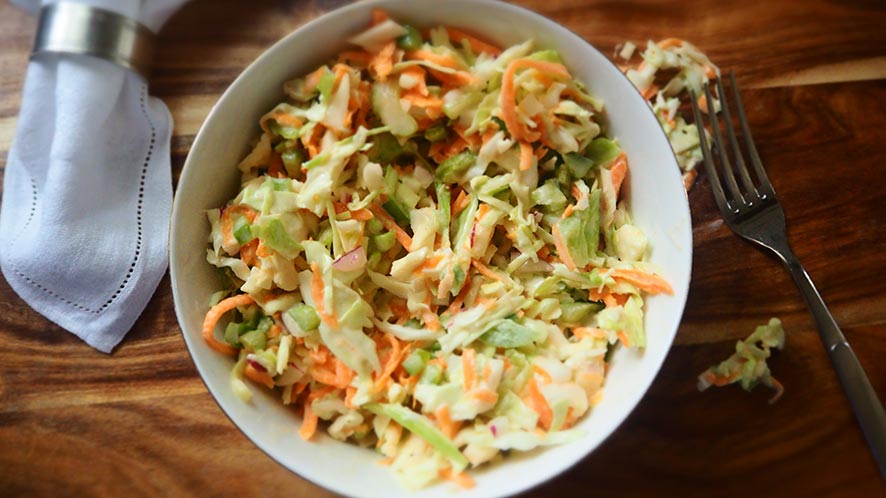Coleslaw Nutritional Value and 8 Cooking Tips
Originating from the Dutch words “kool” and “sla” meaning cabbage salad, coleslaw is inarguably one accompaniment that pairs well with almost all dishes. The finger-licking combo of shredded cabbage and creamy mayo dressing gives this crispy dressing much of its characteristic zing.
Mainly prepared using shredded raw cabbages and other shredded fruits and vegetables like carrots, apples, onion, and others, this crunch-tastic summer favorite packs in a good deal of taste and health too. Of Irish origin, coleslaw has spread throughout the world as a side dish.
Many meat dishes have coleslaw as an accompaniment with barbecues and fried chicken topping the list of favorites. It can also be taken with food items like French fries and is an indispensable part of burgers, sandwiches, hamburgers, and hot dogs. As it is easy to make, it is also popular at picnics, cookouts, or barbecue bashes.
Variations of coleslaw have also come to become a part of our popular food culture. A vast variety of ingredients like buttermilk, mayonnaise, vinegar, celery seed, pepper, and others are now included in coleslaw. Some variations even use ketchup in place of mayonnaise. To learn about the nutrition coleslaw offers, explore this write-up.

Coleslaw Nutritional Value
Amount of Coleslaw: 1 cup
Total Weight of Pistachio: 120g
| Nutrients | Amount |
| Basic Components | |
| Calories | 69 |
| Calories from Fat | 23 |
| Fat | |
| Total Fat | 2.61g (4%) |
| Saturated Fat | 0.385g (2%) |
| Polyunsaturated Fat | 1.351 g |
| Monounsaturated Fat | 0.708g |
| Cholesterol | 8mg (3%) |
| Sodium | 23mg (1%) |
| Potassium | 181mg |
| Total Carbohydrate | 12.41g (4%) |
| Dietary Fiber | 1.5g (6%) |
| Sugars | |
| Protein | 1.29g |
| Vitamins | |
| Vitamin A | 7% |
| Vitamin C | 54% |
| Calcium | 4% |
| Iron | 3% |
Cabbage
Cabbage, which is the major constituent of coleslaw, is rich in vitamins and low in calories. Cabbage is found to have Vitamins A, C, K, E, and B9. It is also rich in elements like sulfur, calcium, potassium, and iron.
Carrot
Carrot, which is the most preferred accompaniment to cabbage, is also rich in vitamins. It is a source of Vitamins A, K, C, E, B6 and B9. Carotene, which is abundant in carrots helps in cell renewal. Carrots have also long been known for their positive effect on eyesight. Teeth and skin are also benefited by the intake of carrots. Carrots are also rich in potassium, calcium, magnesium, and phosphorous.
Mayonnaise
Mayonnaise is the substance that contributes the most to the calorie count of coleslaw. Though most mayonnaise is generally high in fats, low-fat ones are also available now which can be used to reduce the fat and calorie count. In addition to carbohydrates, mayonnaise also provides calcium, iron, magnesium, zinc, Vitamins E, and K. It is also high in sodium content.
Vinegar
You can use any vinegar while preparing coleslaw. White wine vinegar is the most used. However, it does not add much to the nutritional value of the dish. The only significant contribution is the presence of sodium.
Celery Seeds
Celery seeds are added to the dish only according to individual preferences. Celery seeds have small amounts of fat, carbohydrates, and protein in addition to traces of calcium, iron, zinc, copper, selenium, vitamins C and A.
Sugar
In addition to the obvious sweetness, sugar adds a fair amount of calories and carbohydrates. In addition, small amounts of potassium, zinc, selenium, and iron are also found in sugar.
Cooking Tips
- Coleslaw is one of the most popular salads. Any fruit or vegetable of your preference can be added to shredded cabbages.
- Add vegetables or fruits high in nutrition to make the dish healthier.
- You can marinate it with vinegar or mayonnaise, again according to your preference.
- Go low on the mayonnaise or use low-fat mayonnaise for healthier coleslaw.
- An adequate amount of salt is also added. Salt not only adds to the taste but also is essential to your health.
- To make your coleslaw healthy, it’s best if you opt for non-creamy recipes, as doing so would significantly slash the calorie content of it.
- To ensure that your coleslaw is both high on health and taste, introduce interesting flavors, ingredients, colors, and spices to it for more nutrition and variety.
- Dieters and weight-watchers can simply enjoy their coleslaw by making simple substitutions like swapping high-fat mayo with low-fat yogurt and replacing whole eggs with egg whites.
For more zest, you can add red or yellow onions, some lime juice, honey, sunflower seeds, fresh orange juice, apple cider vinegar, etc. Doing so won’t just notch up the taste of your slaw, but also make it more nutritious and gratifying to the health.
